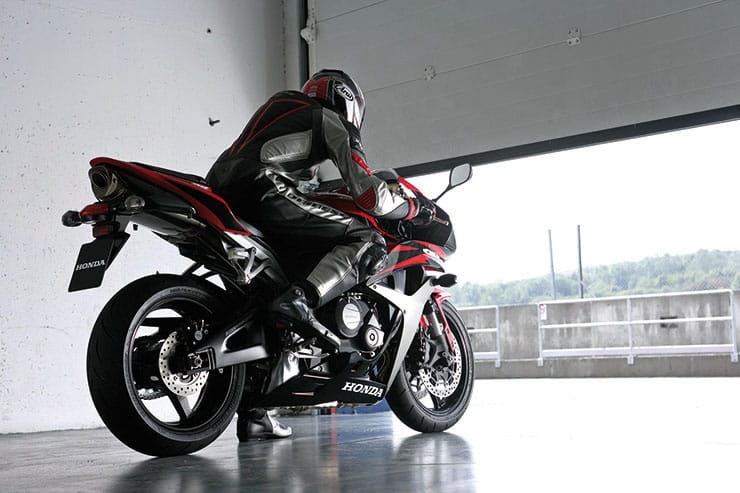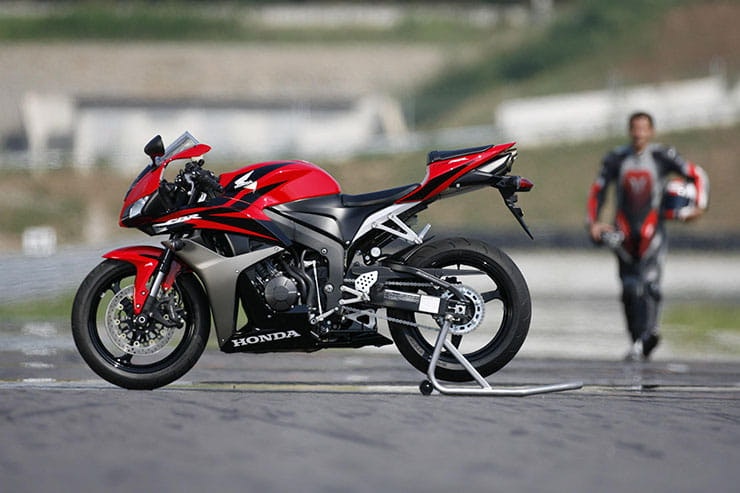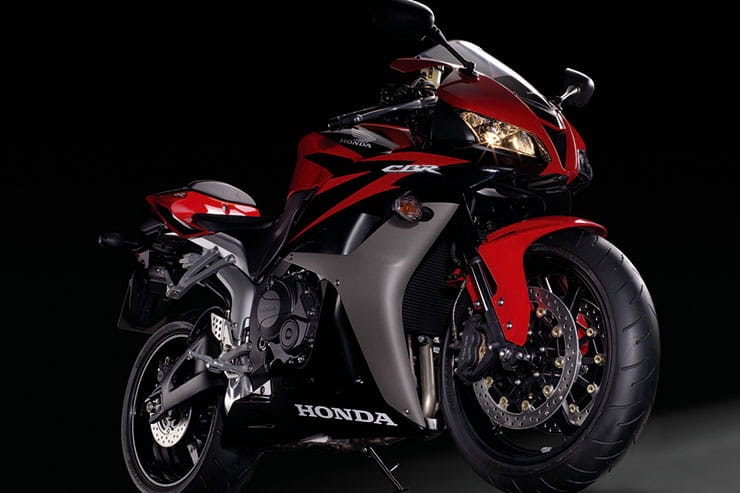Honda CBR600RR (2007-2012): Review & Buying Guide
By Jon Urry
Massively experienced road tester
25.04.2023
Price: £4500-£6500 | Power: 119bhp | Weight: 186kg | Overall BikeSocial Rating: 4/5
In 2007 Honda released their second incarnation of CBR600RR. Far more than just a few tweaks here and there, this model is actually substantially changed from the original RR (2003-2006) and its new engine went on to form the basis for not only every future CBR600RR but also the CBR650 and CB650 models, which are still in production today, and even the current (but not sold in Europe) CBR600RR, which is racing in WSS. In RR guise, this generation of CBR technically ran from 2007 until 2012 however the 2013 bike was basically just a facelift and tweak to its suspension, so to all intents and purposes, the 2007 RR ran for nine years before its production was stopped due to emission regulations and the decline in the European supersport market. A bike that was so right it arguably never needed changing in nearly a decade of production, this generation is a solid machine for the road that is well built, reliable and fun to ride. It still has the usual supersport irritations, namely a bit of a rev-happy motor when you are used to a bigger engine and a cramped riding position, but it isn’t actually that bad and owners rightly love them.
Honda CBR600RR (2007-2012) Price
Prices of the CBR600RR tend to hit a plateau and stay there, so even in the private market 2007 bikes go for close to £5000. You may save £500 on one that has done a high-ish mileage (over 20,000 miles), but there is little price difference between a 10,000-15,000-mile example and a 20,000-mile one so you might as well spend a bit extra. If you want a 2012 model you need to pay roughly £6000-£6500, but as the CBR didn’t change between 2007 and 2012 you are better off buying on condition and mileage rather than year. ABS tends not to command any premium in the used market, treat it as an added bonus if the bike has it but remember the system does require extra work when it comes to changing the brake fluid...
Stronger than normal supersport engine
Solid build quality
Easy and cheap to upgrade
It is still quite small and compact to ride
The ABS system isn’t great on track
The look is a touch dull
Engine and Performance
The CBR’s inline four is a completely new engine compared to the original (2003-2006) generation’s motor. An impressive 2.1kg lighter than the previous engine, it has the same bore and stroke as the older motor but is physically smaller while also including a few tricks to help boost its mid-range. Alongside the usual reduction in weight of internal components, the CBR gained new intake ports and velocity stacks that were developed to give it more guts as well as a central forced air intake and new fuel-injection system – and the results speak for themselves.
Although peak power is only increased by a claimed 3bhp to 119bhp (realistically that’s 109bhp at the rear wheel) this generation of CBR feel far less rev-hungry than the older model. Swap from the previous generation to this one and you would swear Honda have done the same trick as Kawasaki and upped its capacity to 636cc – but they haven’t, it’s still 599cc. Happy to pull through its mid-range while still delivering that wonderful supersport kick of top-end acceleration, the CBR600RR makes for the best inline four Japanese supersport bike on the road and is far from hectic or demanding to ride. It’s no litre bike and you still need to work the gearbox but you aren’t continually tap-dancing on the lever. And it is reliable too, which is very important for used bike buyers.
There are very few horror stories when it comes to the CBR600RR’s engine and it seems to be able to more than soak up general road riding. You get the occasional story of a sensor failing here and there but generally if left in standard trim (or only a pipe fitted) all is well. A few owners send their bike off to get remapped on a dyno either via an ECU reflash or fuelling module, which is quite a good thing to do, and some go as far as removing the flapper in the airbox to gain a few bhp gain low down and disconnecting the air bleed system (pointless, it won’t gain any performance). If you get a remap owners recommend reducing the point at which the cooling fans kick in to make the bike run cooler and you can also turn off the Fi warning light that comes on if you have fitted a full system and removed the exhaust valve or O2 sensor. But a word of caution here as often these same owners also fit an aftermarket quickshifter, which can lead to gearbox issues and so is best avoided.
When it comes to servicing, always be aware the costly valve-clearance service is at 16,000 miles. As the CBR is so compact access is very tricky to the motor and just checking the valves (alongside a service) will set you back over £600 with adjusting them (usually this isn’t required) adding £100-£200. Speaking of servicing, always check the fairing panels on an RR as they are very fiddly to undo, something that often leads to cracks due to them being forced. A few owners alter the RR’s gearing (stock is 16/42), which is a cheap way to give it a bit more urgency on the throttle.
Honda CBR600RR (2007-2012) Handling & Suspension
Honda upgraded the RR’s chassis in the 2007 update and it is not only shorter than before but also has more aggressive steering geometry. When you see this there is the worry that the RR will have become a bit flighty (like the ZX-6R...) but this is far from the case. Helped by Honda’s electronic steering damper (debuted on the 2004 Fireblade, this is a smaller and lighter second generation) the RR remains rock solid at speed and yet is incredibly agile in bends. Fun, reassuring and with a superb front end, the RR is a bike you can push hard and gain confidence with and on a set of fresh rubber is more than a match for any more modern supersport bike – especially if you tweak its suspension. The only thing Honda really did to the updated 2013-onwards RR’s chassis was upgrade its suspension (the wheels are a visual update, not performance-enhancing), so if you throw a few quid at a suspension expert to get the forks revalved and a quality aftermarket shock fitted (the OE Showa unit can be rebuilt but the results vary) you will be delighted at the change. As well as plusher damping, an expert will be able to dial out the slight harshness in the RR’s ride quality which is down to overly-firm fork springs and shock spring.
When buying used the RR’s chassis can be an area of concern as this is where neglect can bite. Always check the suspension linkages for grease as they seize up if not stripped every four years or so and feel for play in the bearings (wheel, head). If caught early and then kept on top of with regular maintenance all should be well but if neglected these areas can really cause you headaches. And then there are the brakes.
Honda’s C-ABS system arrived as an option in 2009 and isn’t bad on the road but a bit out of its depth on track. A new set of braided lines and uprated pads (careful changing lines on an ABS bike) is recommended if you want to bring it up to modern standards but track riders should probably disconnect the ABS (you can remove a fuse) or buy a bike without it fitted.
Honda recommend the brake fluid is changed every two years or 12,000 miles, which isn’t an issue on a non-ABS bike but on one with ABS fitted can be a pain. The system requires a set procedure to bleed it, which is best left to a qualified technician and will cost you an extra £100 on a service as it is a bit of a laborious process. Always check the fluid to see if it looks nice and clean and if not, be a bit worried as you don’t want to have to replace the ABS system if it gets contaminated – a new unit costs £300. And if the ABS has a fault code displayed be extremely cautious, a new ABS control ECU is £1500!!!
Comfort & Economy
The RR is a supersport bike so you have to expect a cramped riding position, which it does have but it isn’t horrific. Owners often fit an aftermarket screen to help deflect a bit more wind (and also see the clocks as the OE screen is a touch low and can get in the way) and that makes it better but it is still no tourer and its mirrors are crap! Just soak up the discomfort and look forward to the bends instead, which is where the RR shines.
In terms of fuel economy, you can expect about 40-45mpg, which isn’t bad.
Honda CBR600RR (2007-2012) Equipment
As standard you get Honda’s immobiliser system (HISS) but that’s about it on the RR, aside from a fuel gauge, which is quite welcome. Honda sold a range of accessories but realistically the only one worth having is the colour-matched pillion seat cover. Speaking of colours, the CBR600RR was sold in official Repsol replica paint scheme for several model years as well as a Hannspree Rep in 2008 and some fairly hideous ‘limited edition’ colours in 2009. Don’t pay extra for a flash paint scheme and as always, be wary of aftermarket fairings or non-standard colours as that generally means the bike has been crashed.
Owners of CBRs are usually quite conservative with the accessories and short of tail tidies, pillion seat covers, crash protection, bigger screens and loud pipes, most bikes remain close to standard trim. A few owners fit fuelling modules (some can even add traction control) or a plug-and-play gear indicator but major alterations aren’t common.
Honda CBR600RR (2007-2012) Rivals
Owners of the RR tend not to take the bike on track, it is instead reserved for road riding but they will usually cover more miles than owners of other supersport models.
Kawasaki ZX-6R (2007 – 2008) | Approx Price: £4500 - £6000
Power/Torque: 125bhp/45lb-ft | Weight: 184kg
Triumph Daytona 675 (2006-2012) | Approx Price: £3700-£6000
Power/Torque: 123bhp/53lb-ft | Weight: 185kg
Yamaha YZF-R6 (2006-2007) | Approx Price: £5000-£6500
Power/Torque: 131bhp/49lb-ft | Weight: 179kg
Honda CBR600RR (2007-2012) Verdict
The fact Honda left the RR unchanged for so many years tells you all you need to know about this generation. If you are after a supersport bike, it is a great option that isn’t as frantic to ride as some rivals yet still gives you the buzz you need when the right corners arrive. Not only that, a few cheap modifications can make it even better.
Honda CBR600RR (2007-2012) – Technical Specification
Looking for motorcycle insurance? Get a quote for this motorbike with Bennetts bike insurance


